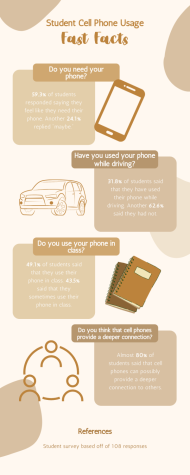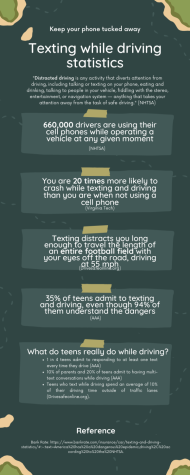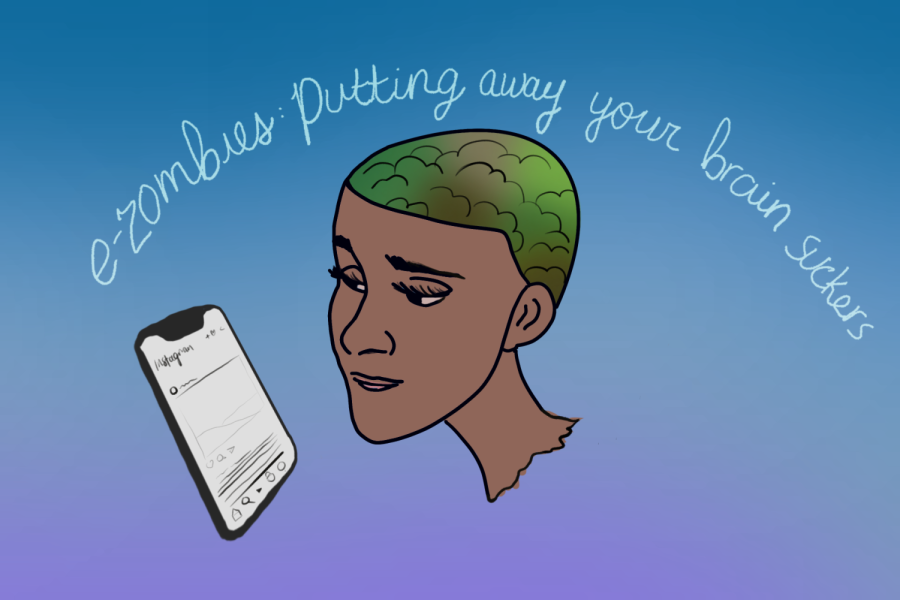E-Zombies: Putting away your brain suckers
Cell phone dependency creates more problems than are normally talked about.
Picture this: you are sitting in class and you hear the sound of your phone ring. You grab your phone and it is a text from your crush. You’re instantly filled with euphoria, but you missed vital information about your final exam.
Generation Z has been exposed to technology, especially cellphones for their whole lives. A large amount of Gen Z teens and children today have had their own phone before or during middle school. Cellphones have a tight grip on how we live our lives, and we are starting to grow numb.
According to Verizon, cellphone addiction is when you feel anxiety when your phone isn’t in reach, it interferes with daily activities, you lose a sense of time and you feel withdrawn from the physical world. Another symptom is having neck pain or eye strain from extensive usage.
Senior J Dziewinski has noticed the constant use of cellphones in today’s society. They use their phone for many different things, including as a purposeful distraction and for communication.
“When I’m feeling anxious, I depend on it more than anything because it distracts me from real life problems and what’s going on around me. I think I’m also dependent on it to contact and talk to my friends. If I didn’t have my phone I probably wouldn’t talk to people as much as I do or be able to make those connections,” Dziewinski said.
111 Students at DGS replied to a survey about cellphone use. When asked if they use their cellphones in class, 92.8% of students said that they use their phone in class. However, when asked if they put their phones away after being asked, 70.3% responded that they put away their phones.

Choir director Joy Belt-Roslieb advocates for being present in learning and enjoying the moment. Since returning to in-person classes, she has noticed a spike in cellphone distractions in the classroom.
“I noticed when we came back in 2021, every single kid was on their phone and it was silent. I don’t remember seeing it so drastically prior to the pandemic,” Belt-Roslieb said.
Belt-Roslieb has been vocal in her classroom about the disruption cellphones have while trying to learn. She has recently tried to get her classroom’s attention by limiting the presence of distractions.
“I am now starting to do gentle reminders if I see a kid with their phone out. ‘Hey, just a reminder, if [your phone] is out I’m going to ask you to put it on the piano.’ I’ll even place my [phone] next to theirs in solidarity. It isn’t to be mean, it is to remove the constant draw that the phone [brings],” Belt-Roslieb said.
As a student, other students’ cellphone usage poses a different type of distraction for Dziewinski.
“If a student is on their phone I think it’s a distraction and annoying for the teacher which is why I try not to go on my phone during a lesson or when working on something, but I dont think it’s a distraction for other students if someone is on their phone unless they are blasting music or TikTok or laughing at their phone. I think kids get distracted by their phones fast if it’s on their desk and not on [do not disturb],” Dziewinski said.
Cellphones are a necessity in society, but there is a time and a place to use them. Sometimes finding a time to turn on do not disturb and enjoy the moment can be more beneficial than leaving it buzzing in your pocket.
The time it takes for someone to read the average text is the same as the time it takes to drive the length of the football field. Driving eyes being occupied by cellphones rather than the road is a problem that has grown over the recent years.
According to the National Highway Traffic Safety Administration, “Distracted driving is any activity that diverts attention from driving, including talking or texting on your phone, eating and drinking, talking to people in your vehicle, fiddling with the stereo, entertainment, or navigation system — anything that takes your attention away from the task of safe driving.”
When asked if they have ever used their phones while driving, 32.7% of DGS students who took the survey responded that they have. However, at least 16% of students taking the survey are not of driving age.
NHTSA reported that “drivers 16 to 24 years old have been observed using handheld electronic devices while driving at higher rates than older drivers have since 2007.”
Driver’s education teacher, Adam Petersen, is surrounded by new drivers on a daily basis.

“Young drivers, due to their inexperience, should be the least distracted while driving so they can focus on the driving task, however that is rarely the case. Whether it is a visual, auditory, cognitive, or a biomechanical distraction, new drivers even with a certified behind the wheel teacher in the car get distracted more frequently,” Petersen said.
Petersen’s top priority is ensuring that he teaches new drivers how to be safe on the road. Distracted driving is largely frowned upon and what drivers education classrooms try to prevent the most while doing physical driving lessons.
“Getting distracted while driving via cellphone usage is inevitable. The best thing to do is to limit these distractions. If you use a music streaming service, get a playlist set up in your parking spot before you start to drive. If you are using GPS get your route set up before you drive and use a phone mount for the GPS to avoid biomechanical distractions and limit visual and auditory distractions,” Petersen said
Petersen continued to talk about when you could be on your phone while in the car.
“Remind yourself that the only time you need to be on the phone while driving is for an emergency and that would be only to make a call to 9-1-1. If it isn’t an emergency it can wait, life is too short, you get one chance and you have to live with the decisions you make. It can only take 1 time to text and drive to cause an accident that can end someone’s life,” Petersen said.
While something may seem important in the moment, it is always important to think before you act and do what is best for everyone’s safety. Wherever you are, you r phone can present itself as a distraction.


